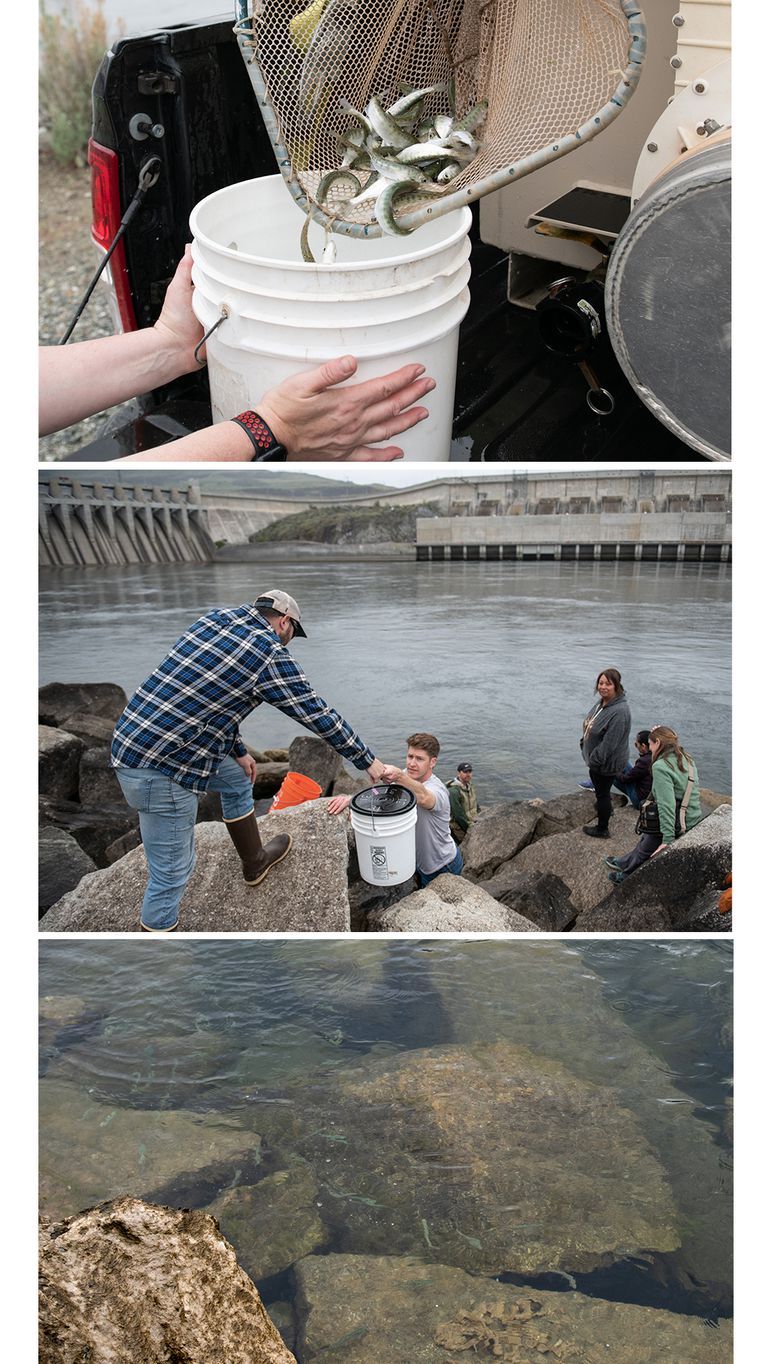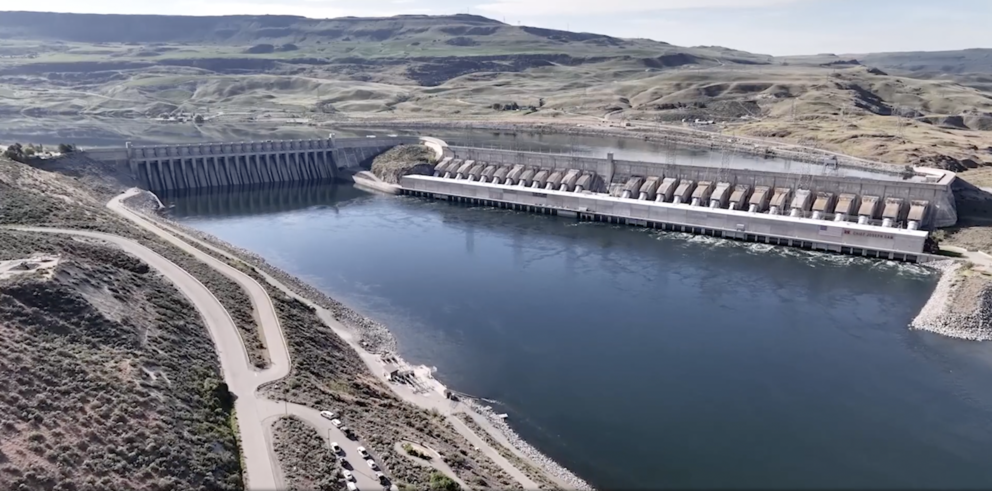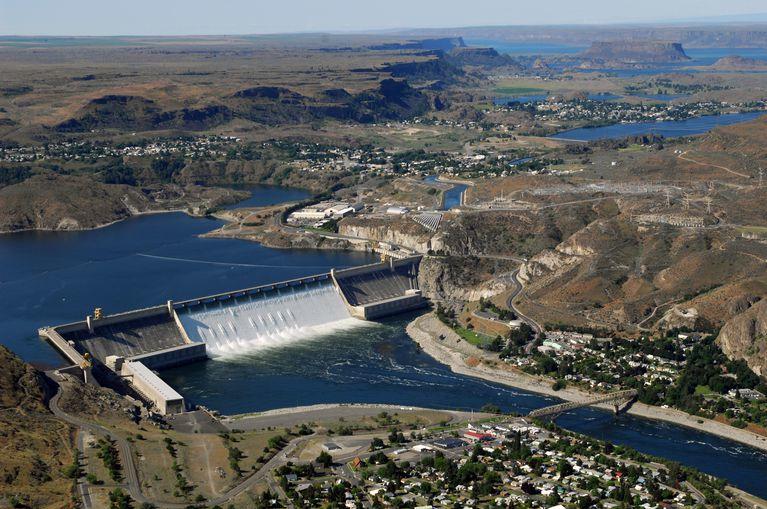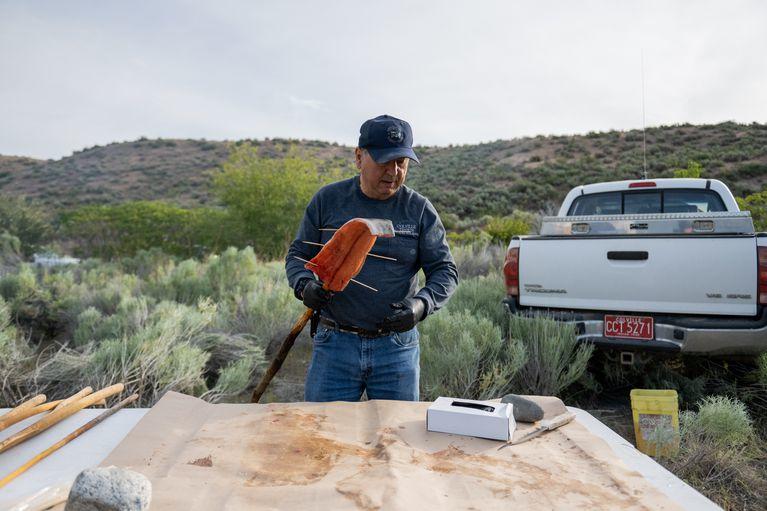Behind them, friends and family had formed a drum circle inside the wooden husk of an old Catholic mission. Back when the salmon were still running up Kettle Falls, the sound of dozens of drum circles would have thundered across the plateau.
But there is only one circle now. And there are no salmon.
Shelly Boyd at the “Sharpening Stone,” June 20, 2021, where generations of Native Americans would hone their harpoon and spear points before catching salmon at Kettle Falls. The stone is atop a bluff overlooking where the fishing grounds stood before they were flooded with the creation of the Grand Coulee Dam. (Kristyna Wentz-Graff / OPB)
Dan Nanamkin of Nespelem leads a social song on the bluff above Lake Roosevelt before the paddlers begin the final leg of their journey, June 20, 2021. Tribes from throughout the Northwest gathered at Kettle Falls to honor the salmon as their ancestors have done for thousands of years. (Kristyna Wentz-Graff / OPB
Former chair of the Colville Tribes Michael Marchand speaks during the Salmon Ceremony. Marchand grew up hearing stories from his grandparents about sharing the fish from Kettle Falls with tribes across the region. He said they worried, after the falls were inundated, that the tribe’s connection to the salmon would disappear. (Kristyna Wentz-Graff / OPB)
The fish cannot get past two federal dams, masses of concrete each hundreds of feet tall. The construction of those dams, which began more than 80 years ago, rendered salmon extinct in hundreds of miles of rivers and destroyed the area’s most important fishing grounds.
“The salmon still keep trying to come, and they come and they hit their little noses on the dam, over and over, ‘cause they hear us calling,” said Conant, a member of the Arrow Lakes and Sanpoil tribes. “So we’re going to keep having our ceremonies and we’re going to keep calling the salmon home until they get here.”
This is part two in a series produced in partnership with the ProPublica Local Reporting Network. Part one: PNW hatcheries aren't saving salmon, investigation finds.
After nearly a century without salmon, Conant and other members of upper Columbia River tribes want to reintroduce the fish into waters long blocked by the dams.
But there’s been something blocking those efforts, too: the Bonneville Power Administration.
The U.S. government promised to preserve tribes’ access to salmon in a series of treaties signed in the 1850s. Upholding those treaties now rests in no small part with Bonneville, a federal agency little known outside the Northwest that takes hydropower generated at Grand Coulee and other dams and sells it wholesale to electric utilities, primarily in Oregon, Washington and Idaho. Decades ago, Congress placed the agency at the center of salmon recovery, giving it conflicting mandates: protect fish and fund their recovery, all while running a business off the dams that have reduced fish populations by the millions.
For decades, judges have admonished the federal government over its failure to do more to protect Columbia River salmon. Most recently, the Biden administration in March took the unprecedented step of acknowledging the harm dams have caused to Native American tribes and calling for an overhaul of Columbia River Basin management. Bonneville, the government’s money-making arm on the Columbia, is the federal agency involved in every measure the Biden team is discussing to save salmon.
But an investigation by Oregon Public Broadcasting and ProPublica has found that Bonneville has, time and again, prioritized its business interests over salmon recovery and actively pushed back on changes that tribes, environmental advocates and scientists say would offer the best chance to help salmon populations recover without dismantling the entire dam system.
The agency said it has invested heavily in supporting salmon and sacrificed revenue to make dams safer for fish. It said any limitations on its fish and wildlife measures are the result of financial pressures.
In response to the news organizations’ findings, Bonneville spokesperson Doug Johnson said in a statement that the agency and its federal partners “will continue to participate in regional discussions on long-term strategies to address the protection and enhancement of salmon and steelhead,” including the White House efforts.
“Ultimately, the region as a whole must continue to advance collaborative solutions to meet the needs of the Pacific Northwest,” Johnson said. Two other federal agencies that work with Bonneville to manage the region’s dams, the U.S. Army Corps of Engineers and the Bureau of Reclamation, issued statements identical to Bonneville’s.
In an interview, Johnson said the agency has had to contain its fish and wildlife spending at levels it could sustain. “The statutes direct Bonneville to operate in a business-like manner,” he said. “Like any other business, we monitor projects in our budgets and make appropriate adjustments as needed.”
Columbia River salmon recovery is one of the most expensive endangered species efforts in the country, costing Bonneville more than $20 billion since it started in 1980. But while Bonneville’s net revenues have surpassed targets in the last few years, it flatlined or reduced budgets for fish recovery at a time when, according to salmon advocates, more money is needed than ever to prevent extinctions of more Northwest salmon populations.
Proposals on the table, according to the White House and other participants in the talks, include breaching dams on the lower Snake River in southeastern Washington, funding the reintroduction of salmon into blocked areas and removing Bonneville from salmon management.
“We cannot continue business as usual,” the White House memo said.
But on each of those three issues, interviews and documents show, business as usual is what Bonneville has tried to preserve.
Building to a crisis
The Bonneville Power Administration began as a federal agency designed to run as a business. And, in many ways, that has never changed.
The agency was created in 1937, when Pacific Northwest hydroelectric dam-building had just begun and federal officials spoke openly about sacrificing salmon runs for the sake of developing cities and farmland. Bonneville was the government’s way to market the dams’ hydropower and electrify the rural West.

The successful harnessing of the Columbia for electricity became synonymous with American pride over settling the West and winning World War II. Massive flows of water rushed down through tunnels, spinning turbines and generating electricity that in turn powered homes and factories, most notably aluminum plants that manufactured bomber planes. Bonneville even hired Woody Guthrie to write folk songs about Uncle Sam putting the river to work for factories and farmers.
Although the dams are owned and operated by different agencies, Bonneville co-manages them, covering construction debts and operating costs with the proceeds from the electricity that the dams generate. Bonneville sells electricity to public utilities, which in turn sell it to homes and businesses. Today, Bonneville’s operating revenues are more than $3.8 billion per year. It manages power from 31 dams and owns about 75% of the Pacific Northwest’s power lines.
But what was good for generating power was devastating for fish. In the mid-1950s, when wild chinook salmon on the Snake River had to pass just one dam on their journey to the ocean, they numbered about 90,000. By 1980, seven additional dams later, the Snake River population had fallen to around 10,000.
In some places, like the Grand Coulee and Chief Joseph dams in northeast Washington, there is no way for fish to pass through at all, and the salmon are entirely gone upriver from the dams. While the rest of the federal dams on the Columbia and Snake rivers include ways for salmon to migrate past them, these passages still take a toll. Fish can get thrashed by turbines if they pass through the dam’s powerhouse. They suffer in the warm and stagnant reservoirs that replaced free-flowing water when the rivers were dammed. And they fall prey to predators like sea lions, which have thrived in the conditions the dams created. Scientists say many fish that pass through multiple reservoirs and dams end up dying later on from the stress of the journey.
Faced with the possibility of federal agencies labeling salmon as endangered, Congress took action in 1980: It passed the Northwest Power Act, tethering the fate of salmon to that of the Bonneville Power Administration. The act required Bonneville to fund a comprehensive fish and wildlife program, and to “protect, mitigate, and enhance fish and wildlife to the extent affected by the development and operation of any hydroelectric project of the Columbia River and its tributaries.”
The new law established conflicting mandates for Bonneville: making money from hydropower while helping save salmon from extinction. And by the 1990s, it was clear the measures were failing to rescue salmon. Several populations became listed as threatened or endangered and salmon advocates filed lawsuits over federal dam operations.
As part of an ongoing court case that has lasted decades, judges have ordered federal agencies, including Bonneville, to improve special passageways that allow fish to bypass dams’ turbines. Judges also ordered the agencies to increase their “spill,” meaning the amount of water they allow to flow past a dam instead of into its powerhouse; young salmon on their way to the ocean benefit from that spill, traveling faster past the dam with less likelihood of getting caught in a turbine.
But for Bonneville, every drop that didn’t go through turbines was also wasted fuel and lost revenue — revenue it claimed it could hardly afford to miss out on.
In 2008, Bonneville tried to halt ballooning fish and wildlife costs and lawsuits with a series of funding agreements. The agency doled out $900 million over 10 years to states and tribes for fish and wildlife restoration. But that money came with a catch: Signing the accords required a promise not to sue over management of the Columbia River power system. The accords also required signatories to affirm the adequacy of the federal government’s fish and wildlife mitigation.
Only the Nez Perce Tribe and the state of Oregon declined the money. Along with a dozen fishing and environmental groups, they continued the longstanding challenge of federal dam operations in court.
As the case dragged on, Bonneville faced multiple pressures. It needed to raise its rates to pay for mounting fish and wildlife requirements ordered by the courts, but the Public Power Council, a coalition of consumer-owned public utilities that buy the bulk of its electricity, pushed back. The power council warned Bonneville that it would lose customers if it didn’t curb its rising power costs, a third of which stemmed directly from fish and wildlife measures.
Then, while Bonneville was struggling to improve its finances, salmon fell further into crisis. By 2018, declines in salmon populations triggered an official warning from federal scientists. Scientists had set a threshold that, once crossed, was meant to put the government in urgent action mode to help the fish.
But at the same time, Bonneville was desperate to help itself.
Shortchanging the fish
In 2018, the same year salmon declines were triggering federal alarm bells, Bonneville adopted a new strategic plan meant to fix its finances. It aimed to keep the agency’s fish and wildlife spending from exceeding the rate of inflation; in some years, this spending didn’t end up growing at all. Electricity markets also improved; the agency sold surplus power during times of peak demand like summer heat waves. And it kept expenses low.
Since then, Bonneville’s net revenues have soared past agency targets. Last year, the agency’s net revenues were $360 million above its target. Halfway through 2022, it was on pace for an even better year.
“For the past four years, we’ve done fairly well financially,” Johnson, the Bonneville spokesperson, said. “Five, six, seven years ago, our detractors were talking about the potential for us to go bankrupt because we had so much debt and we were doing so poorly financially. This found solid footing that we have financially is a recent development for us.”
The agency used the unexpected revenues to shore up its cash reserves and lower rates for customers. It didn’t put any of the windfall toward fish and wildlife programs.
In fact, after adjusting for inflation, Bonneville’s current two-year budget for fish and wildlife is down more than $78 million from what it was in 2016-17, before the agency adopted its new strategic plan. That came at a time when scientists said significantly more investment has been needed to give salmon a chance as the climate warms.
“Simply put,” Andrew Missel, attorney for the Idaho Conservation League, wrote in a 2021 brief to Bonneville about its budget process, “in the face of declining salmon and steelhead runs, BPA has decided to starve mitigation projects of needed funds, and has failed to even consider using an expected boon in revenue to help shore up those projects.”
After fish and wildlife agencies told Bonneville its budgets were compromising their efforts, Bonneville announced in June it would increase fish and wildlife spending by about 8% in 2024 based on its assessments of what the program needed to remain viable. That increase would still put it below inflation-adjusted spending levels prior to 2018.
Jeremy Takala, a biologist and member of the Yakama Nation Tribal Council, said the tribe has shovel-ready salmon habitat restoration projects waiting for funding.
“It’s really frustrating,” Takala said in a July speech at a save-the-salmon rally in Portland. “BPA basically managing our funding source, it just does not make sense. It’s a really, really huge conflict that frustrates the tribes.”
Bonneville and its spending have factored heavily into negotiations between salmon advocates and the Biden administration.
Jim McKenna, an adviser to Oregon Gov. Kate Brown who is involved in the negotiations, said Oregon tribes and salmon advocates are asking the administration to greatly increase funding for fish hatcheries and habitat restoration, and to put tribes and other local fish and wildlife biologists directly in charge of how to spend the money.
“The bucket of money is woefully inadequate,” McKenna said. “And, Bonneville is not the agency that should be managing those funds.”
Ultimately, that funding is paramount to whether the government will honor the treaty, signed over 150 years ago, that assured the Yakama tribe of its right to take fish where they always had “at all usual and accustomed places.”
Bill Bosch, who has spent decades working for the Yakama Nation’s fisheries program, said the federal government must fully fund tribes’ hatcheries and habitat efforts, unless it intends to spend the money itself on removing dams and restoring the natural river.
“If you’re not willing to fund one or the other of those,” Bosch said, “then are you basically saying you’re going to abrogate the treaty?”
'Their interests are not fish'
Two years ago, Bonneville and its partner agencies faced a major turning point. The agencies had been scolded by U.S. District Judge Michael Simon for running a dam system that “cries out” for a new approach. He ordered them to conduct a comprehensive environmental impact statement for the Columbia and Snake River dams that included “all reasonable alternatives” to their current actions. The judge hoped the process could “break through any logjam that simply maintains the precarious status quo.”
By 2020, Bonneville and its dam co-managers, the Army Corps of Engineers and the Bureau of Reclamation, released their long-awaited new master plan for the river. Despite Judge Simon’s hopes, the plan mostly preserved the status quo.
The plan hinged on a proposal the federal bodies called “flexible spill.” For years, the courts had been ordering them to spill water past their dams to aid fish migration. Under the flexible spill plan, they’d spill as much water as they could when it wasn’t needed to make electricity. The plan was an experimental concept, but modeling showed it could increase the number of salmon that survive their migration to return as adults by as much as 35%, and the agencies hoped it could become their long-term solution.
For many salmon biologists, the plan wasn’t the solution it purported to be. They argued such measures hadn’t seen enough real-world use to establish how fish actually responded, and said even the predicted 35% increase wouldn’t be enough to halt the decline of salmon populations. And, they said, other aspects of the federal plan gave dam operators leeway to slow or even stop the flow of water behind dams at times, making it harder for salmon to migrate out to sea.
In many regards, the agencies’ plan was a step backward for salmon compared to what courts had already rejected, said Michele DeHart, manager of the Fish Passage Center, a small federal research body funded by Bonneville.
Records show that DeHart provided Bonneville and its co-managers with analyses demonstrating that they were overstating the benefits of their preferred course of action for the Columbia River, and that it would likely lead to a further decline of the river’s fish.
Still, all three federal bodies proceeded with their preferred option, which they said struck a balance between clean energy, economics and fish and wildlife needs.
At the same time, Bonneville and its partners have rejected an increasingly popular suggestion for saving several of the Columbia basin’s salmon populations from extinction: taking four dams on the lower Snake River in southeastern Washington out of operation and restoring the natural flow of water.
The Fish Passage Center, the Nez Perce Tribe, and more than 60 scientists have all concluded that breaching the four dams is the only scenario that has a likelihood of allowing Snake River salmon populations to recover. In July, the National Oceanic and Atmospheric Administration called breaching the dams “essential” for healthy salmon runs.
The dams generate just 4% of all the power sold by Bonneville, but breaching them is opposed by the public utilities that make up Bonneville’s customer base and by farmers, who rely on the dam-impounded reservoirs to irrigate their crops and barge them downriver. Two separate reports released this year, one by Washington elected officials and the other by the Department of Energy, concluded the services of the four dams could be replaced, with a total cost between $10 billion and $30 billion.
Public utilities have spent millions on public relations campaigns in support of keeping the lower Snake River dams. They have pushed Bonneville to be more aggressive in opposition to breaching any dams. They say the dams are crucial to the region’s goals of reducing carbon emissions and fighting climate change, which presents another major threat to salmon.
Though Bonneville has not vocally opposed dam removal, behind the scenes it worked to sway public opinion in favor of keeping the dams fully operational. The agency drafted talking points in 2019 and distributed them to public utilities for use in conversations about the dams, instructing them that “BPA would prefer to NOT have these statements attributed to the agency.”
In 2020, the agency sent emails to a dozen news organizations “correcting the record” with facts about the importance of the dams, and tried to pitch reporters on an angle about the questionable benefit to salmon of breaching the Snake River dams when compared to the importance of the clean energy the dams produce.
“How many more fish would it actually bring back? Would it be worth it?” an agency communications staffer, Dave Wilson, said in one email to an NPR reporter.
Both Bonneville and its public utility customers have pointed to a handful of studies, funded by Bonneville, that cast doubt on the effectiveness of dam removal.
Asked about the emails, Johnson said Bonneville wanted the public to understand the importance of the dams to public power, and for the region to understand what it would be giving up if the dams are breached.
DeHart, of the Fish Passage Center, said it should come as no surprise when Bonneville protects dam operations.
“It is BPA’s job to protect their interests, and they’re doing a good job,” DeHart said. “They’re protecting their own interests, and their interests are not fish.”
Nowhere are those interests more significant than on the upper Columbia River, where two massive dams produce roughly half of all the power Bonneville sells.
Bonneville and its partners have operated those dams without any way for fish to pass them for more than half a century.
That, the Spokane Tribe argued in court documents, “has been nothing short of an attempt to permanently destroy a culture.”
A year ago, Michael Marchand sat on the banks above the Columbia, his long white hair blowing in the wind as he watched members of his tribe perform a salmon ceremony without any salmon. The former chair of the Colville Tribes grew up hearing stories from his grandparents about sharing the fish from Kettle Falls with tribes across the region. He said they worried, after the falls were inundated, that the tribe’s connection to the salmon would disappear.
In the water below him, Conant and other ceremony organizers and tribal leaders were ankle deep in the current. They stood with a stone in each hand, lifted them into the air and rapped them against each other. The crowd on the banks echoed them, and soon the rhythmic clacking of their salmon call drowned out even the speedboaters in the distance. Before the dam drove them extinct on this part of the Columbia River, the salmon passing Kettle Falls were legendary, growing to the size of an 8-year-old child and capable of hurdling waterfalls and navigating by smell for more than 1,000 miles to reach their home streams.
Upper Columbia tribes have a multiphase plan to restore salmon in those waters: transplanting fish above the dams to establish populations, then creating new systems of fish passage, like trapping fish and trucking them around the dams, a technique already used on other rivers.
It’s not just about restoring the tribes’ own fisheries. The rivers and streams above Grand Coulee Dam offer some of the best remaining cold-water habitat for salmon, and could be a bastion for the fish amid climate change. Reintroduction has been endorsed by the Northwest Power and Conservation Council, which oversees the fish and wildlife program funded by Bonneville, and more recently by NOAA. It’s part of the ongoing negotiations between salmon advocates and the Biden administration, which have also discussed dam breaching and shifting Bonneville’s fish and wildlife responsibilities to states and tribes.
But, so far, tribes in the upper Columbia say they haven’t been able to get the help they need from the federal government, which by treaty and federal doctrine is the trustee of their rights.
“The government’s been fighting us about putting these fish here,” said Marchand, who served on the Colville tribal council when upper Columbia tribes released their plan for reintroduction. “Part of it is energy costs. And part of it’s just, to me, it’s just raw power politics.”
Because salmon are extinct above Grand Coulee Dam, Bonneville doesn’t currently have to worry about how well fish pass the dam and all the costs associated with that. But upper Columbia tribes say they’ve designed their reintroduction plan to work within existing dam operations and have no intention of jeopardizing power production.
Bonneville and its partners have refused to evaluate the idea of bringing salmon back to the upper Columbia. Collectively, Bonneville, the Army Corps and the Bureau of Reclamation told the tribe that fish passage was too complicated and too time-consuming to include in their plan for the river.
“You’re talking about roughly half of the production of the entire system with those two very large dams on the upper Columbia,” Johnson said. “That could introduce fairly high costs and a lot of upward rate pressure for Bonneville’s power customers.”
Johnson called it a very complex issue, and one that “warrants a lot of discussion.”
Bonneville has created other obstacles to the reintroduction of fish. The Spokane Tribe told the agency in 2019 that its “lack of funding and stonewalling” put their efforts three years behind schedule. The Colville Tribes say it has been more difficult to get funding for the fish reintroduction than for any other fish and wildlife project. And in 2018, when the Colville Tribes and Bonneville were due to renew their funding accord, the agency included provisions in the new agreement that forbid the use of any accord funding in the tribe’s reintroduction efforts. It also forbade the tribe from using any fish from their Chief Joseph Hatchery for relocation.

Two tribes partnering with the Colville on reintroduction efforts asked Bonneville to remove the language: One called it “meddling” and the other said it “directly undermines” its efforts “in seeking cultural restitution for lost resources.” But Bonneville kept the language, and with roughly $68 million in funding — and the many jobs that this money would sustain — riding on the accord, the Colville Tribes signed.
Bonneville said reintroduction above Grand Coulee Dam isn’t what Congress authorized the hatchery for, but that it is working with tribes to find a path forward.
Meanwhile, tribes have worked around the restrictions to try to reintroduce fish.
In 2019, they began to capture adult salmon that were returning from the ocean and relocated them above the dams. Conant, who organizes the salmon ceremony, was among the tribal members who released those captive fish into the water. To her delight, biologists later found salmon from the tribes’ releases spawning in the Sanpoil River, a tributary of the upper Columbia.
“It’s not necessarily like, oh, ‘salmon’s the magic food that saves the Indian!’” Conant said. “But it brings back fishing. It brings back taking care of the fish, cutting and drying it, processing, spending that time with your uncle, spending that time with your grandma. It brings it all back.
“There’s bits and pieces of all of our hearts that are missing,” Conant said. “We’re filling our hearts back up and fighting our way back to our culture.”
Members of the Spokane Tribe were amazed to discover in 2019 that some of the juvenile Chinook salmon they tagged with trackers and released above Grand Coulee Dam somehow not only made it downriver through Grand Coulee and Chief Joseph dams despite their lack of dedicated fish passageways, but made it more than 600 miles to the ocean.
One of those salmon returned as an adult, swimming all the way back to the Chief Joseph Hatchery at the base of its namesake dam.
But its journey ended there. The federal agencies’ protocols prohibited tribes from relocating the captured salmon above Grand Coulee Dam.
Instead of returning to its home waters, it died below the dam.
This story was produced for Oregon Public Broadcasting and ProPublica on Aug. 4, 2022. ProPublica is a nonprofit newsroom that investigates abuses of power. Sign up here to get its next investigation. OPB is a member of the ProPublica Local Reporting Network.































